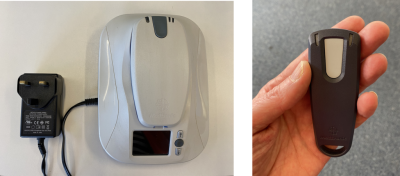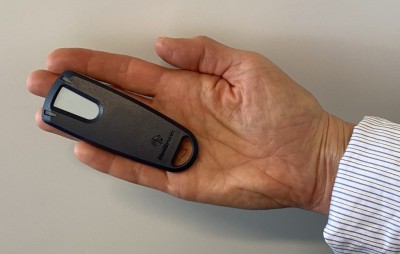Neurodiversity information for parents and young people
How to use your home monitor
When we implant your ILR device, a healthcare professional will sync your implanted device to your home monitor unit. They will do this before you go home. They will also explain to you how to use the home monitor.

- When you get home, plug in your home monitor and leave it by your bedside.
- Make sure it is never located more than 3 metres away from your bedside.
- The bedside home monitor unit comes with an additional small, blue portable device, about 10 cm long. You can attach it to a lanyard or keychain. Keep the portable device with you at all times if possible. This means we can monitor your symptoms closely.
The bedside monitoring unit will show flashing lights while it is transmitting signals to us.
![]()
Contact the device manufacturer patient advice line if you notice an error code on your device (see Contacts section).
Once you have plugged in the home monitor, you do not need to do anything else unless the hospital calls you with instructions.
Benefits of using a home monitor
While you sleep, the home monitor will send us information about the way your heart is functioning.
If you experience heart symptoms
If you experience symptoms, press button on the small blue portable device. When you do this, the device sends a trace of your heart rate and rhythm to the Kingston Hospital Pacing Clinic team.

Symptoms can include:
- Chest pains
- Palpitations (fluttering) or feeling as though your heart is skipping a beat
- Feeling dizzy or light headed
- Collapsing or fainting
- Any other symptoms which you experienced before we inserted the device.
Do not worry if you press the device button after you experience symptoms. The device stores a trace of your heart rate and rhythm for up to 15 minutes before you press the button.
Important
![]()
Go to your nearest Emergency Department (A&E) if you experience severe symptoms such as sharp chest pains, a faint or collapse, or any symptoms that make you feel extremely unwell.
How often we check the signals from your device
The Kingston Hospital Pacing Clinic team checks every signal that your home monitor transmits to us.
We contact you if we notice problem signals or want to discuss symptom episodes with you.
If you do not hear from us, it means we have assesssed your heart rate and rhythm to be normal.
If you have sent a symptom episode are are wondering if we have seen it, get in touch with us (see Contacts section).
If you go on holiday
If you are planning to go on a short holiday (up to 2 weeks) you can leave your bedside home monitor unit at home. Take the small, portable device with you in case you need to record a symptom episode while you are away.
If you are going on holiday for more than 2 weeks, we advise you to take your home monitor bedside unit, and the portable device, with you. When you reach your holiday destination, set up the home monitor in your bedroom in the same way that you do at home.
![]()
Let us know if you are going on holiday (see Contacts section).
If you notice an error code on your device
If you notice an error code on your device, get in touch with the Kingston Hospital Pacing Clinic (see Contacts section).
More information
NHS information on implantable loop recorders
NHS information on having a pacemaker fitted
Contact information
Kingston Hospital Pacing Clinic, Monday to Friday 9am to 5pm
or
Medtronic Home Monitoring Support Team UK, Monday to Friday, 8am to 4 pm
or
Boston Scientific Latitude patient advice team
or
Abbott (St Jude Medical) Merlin patient advice team
Telephone:
Pacing Clinic: 020 8934 3872
Medtronic: 0800 2666 3282 or 01923 202 543
Boston Scientific Latitude: 0800 678 1644
Abbott (St Jude Medical) Merlin: 0800 389 2714